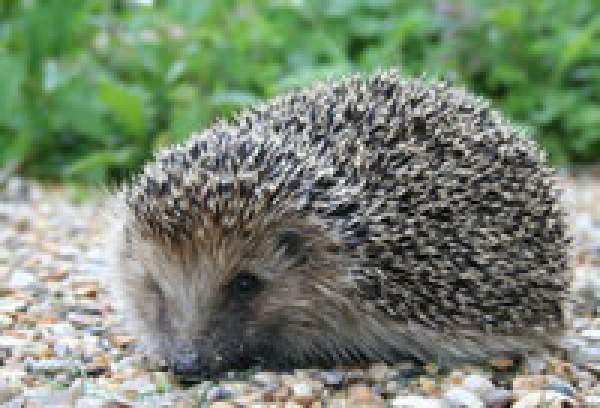Hedgehog
Erinaceus europaeus

The Hedgehog should be instantly recognisable and there is no other British mammal that looks anything like it. Males are usually bigger than females but these differences are masked by variations between individuals in terms of their age, or by seasonal effects. Because of their nocturnal habits, visiting Hedgehogs may be overlooked within the garden environment, but it is worth keeping an eye out for their characteristic droppings. These are long (15-50 mm), cylindrical in shape and dark grey or black in colour, usually with shiny insect remains obvious within them.
Hedgehogs are most commonly encountered in mixed landscapes, where grassland, scrub and woodland edge come together. They readily use gardens, and in some areas may make greater use of these than the surrounding landscape. The short turf of lawns and other amenity grassland provides access to earthworms and other invertebrate prey.
Hedgehogs are protected from being trapped under the Wildlife and Countryside Act 1981 without a licence. However, they do appear to be in decline through habitat loss. Gardens are a safe haven for them if long vegetation is left for them to sleep in, and bonfire heaps are turned over before being burned.
Hedgehogs spend part of the year (typically from November to March) in hibernation, as the BTO Garden BirdWatch reporting rate (below) shows. Most activity takes place at night, but individuals may sometimes be encountered at dusk or dawn. Those seen abroad during daylight hours are likely to be facing some form of food shortage, perhaps the result of summer drought or a need to take on fat reserves ahead of entering hibernation.
Beetles, caterpillars and earthworms are the principal prey taken, although Hedgehogs may occasionally take carrion and predate the eggs of ground-nesting birds.
Individuals may range over some distance, often covering 1-2 km during the course of a night, with sexually mature males covering a greater distance than the females. During the day, Hedgehogs use 'summer nests', similar to those used for hibernation but often only used for a few days before the animal moves on to another refuge.
Females have litters between April and September. The later the young are born, the more likely they are to die as they will be too small to survive hibernation.
GBW volunteer Michelle Gault has assisted us with the following article about Hedgehogs:
Sadly, Hedgehogs have declined by around a third in urban areas since 2000. You can find out about the contributing factors to this decline on the Hedgehog Street website.
The Gardenwatch preliminary results showed that less than 20% of participants fed Hedgehogs in their gardens or provided Hedgehog homes.
There are several things that you can do to help the Hedgehogs in your garden:
- Provide safe and appropriate food to help these mammals put on weight quickly to ensure a successful hibernation.
- Add plants to your garden that attract invertebrates and provide ground cover.
- Ensure fences between gardens have gaps so that Hedgehogs can move from one garden to another.
- Provide a Hedgehog home for them to hibernate in.






Share this page